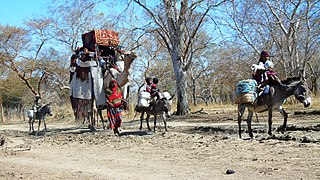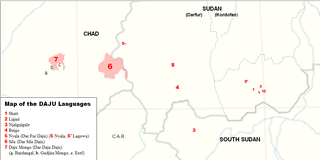Related Research Articles
The Nubian languages are a group of related languages spoken by the Nubians. In the past, Nubian languages were spoken throughout much of Sudan, but as a result of Arabization they are today mostly limited to the Nile Valley between Aswan and Al Dabbah. In the 1956 Census of Sudan there were 167,831 speakers of Nubian languages. Nubian is not to be confused with the various Nuba languages spoken in villages in the Nuba mountains and Darfur.

The Baggāra or Chadian Arabs are a nomadic confederation of people of mixed Arab and Arabized indigenous African ancestry, inhabiting a portion of the Sahel mainly between Lake Chad and the Nile river near south Kordofan, numbering over six million. They are known as Baggara and Abbala in Sudan, and as Shuwa Arabs in Cameroon, Nigeria and Western Chad. The term Shuwa is said to be of Kanuri origin.
Tama, or Tamongobo, is the primary language spoken by the Tama people in Ouaddai, eastern Chad and in Darfur, western Sudan. It is a Taman language which belongs to the Eastern Sudanic branch of the Nilo-Saharan language family. Miisiirii is often considered a dialect, though it is not particularly close.
The Masalit are an ethnic group inhabiting western Sudan and eastern Chad. They speak the Masalit language.

Daza is a Nilo-Saharan language spoken by the Daza people inhabiting northern Chad and eastern Niger. The Daza are also known as the Gouran (Gorane) in Chad. Dazaga is spoken by around 700,000 people, primarily in the Djurab Desert region and the Borkou region, locally called Haya or Faya-Largeau northern-central Chad, the capital of the Dazaga people. Dazaga is spoken in the Tibesti Mountains of Chad, in eastern Niger near N'guigmi and to the north. It is also spoken to a smaller extent in Libya and in Sudan, where there is a community of 3,000 speakers in the city of Omdurman. There's also a small diaspora community working in Jeddah, Saudi Arabia.

Lower Nubia is the northernmost part of Nubia, roughly contiguous with the modern Lake Nasser, which submerged the historical region in the 1960s with the construction of the Aswan High Dam. Many ancient Lower Nubian monuments, and all its modern population, were relocated as part of the International Campaign to Save the Monuments of Nubia; Qasr Ibrim is the only major archaeological site which was neither relocated nor submerged. The intensive archaeological work conducted prior to the flooding means that the history of the area is much better known than that of Upper Nubia. According to David Wengrow, the A-Group Nubian polity of the late 4th millenninum BCE is poorly understood since most of the archaeological remains are submerged underneath Lake Nasser.

The Daju languages are spoken in isolated pockets by the Daju people across a wide area of Sudan and Chad. In Sudan, they are spoken in parts of the regions of Kordofan and Darfur, in Chad they are spoken in Wadai. The Daju languages belong to the Eastern Sudanic subfamily of Nilo-Saharan.

In most classifications, the Eastern Sudanic languages are a group of nine families of languages that may constitute a branch of the Nilo-Saharan language family. Eastern Sudanic languages are spoken from southern Egypt to northern Tanzania.
The Taman or Tamaic languages form a putative branch of the Eastern Sudanic language family spoken in Chad and Sudan, though Glottolog notes that "no conclusive, methodologically sound basis for assigning Tama to Eastern Sudanic" has been presented.
Sungor is an Eastern Sudanic language of eastern Chad and western Sudan and a member of the Taman branch. It is closely related to Tama with some resarchers speaking of a Tama-Assangori continuum.
The Tunjur people are a Sunni Muslim ethnic group living in eastern Chad and western Sudan. In the 21st century, their numbers have been estimated at 175,000 people.
Tama are a non-Arab, African ethnic group of people who live in eastern Chad and western Sudan. They speak Tama, a Nilo-Saharan language. The population is 200,000–300,000 people and they practice Islam. Many Tama are subsistence farmers who live in permanent settlements and some raise livestock. In the civil war in Chad (2005–2010) the Tama were involved in ethnic conflicts with the Zaghawa tribe.
The Mararit are an ethnic group of Chad and Darfur, Sudan. Most members of this ethnic group are Muslims. They speak the Mararit language, which is a Nilo-Saharan language. The population of the group is estimated at 32,000.

The Nara (Nera) or Barea (Barya) language is spoken by the Nara people in an area just to the north of Barentu in the Gash-Barka Region of western Eritrea. The language is often confused with Kunama, which is at best only distantly related.

Sudan is a multilingual country dominated by Sudanese Arabic. In the 2005 constitution of the Republic of Sudan, the official languages of Sudan are Literary Arabic and English.

Chadian Arabic, also known as Shuwa Arabic, Western Sudanic Arabic, or West Sudanic Arabic (WSA), is a variety of Arabic and the first language of 1.6 million people, both town dwellers and nomadic cattle herders. Most of its speakers live in central and southern Chad. Its range is an east-to-west oval in the Sahel. Nearly all of this territory is within Chad and Sudan. It is also spoken elsewhere in the vicinity of Lake Chad in the countries of Cameroon, Nigeria and Niger. Finally, it is spoken in slivers of the Central African Republic. In addition, this language serves as a lingua franca in much of the region. In most of its range, it is one of several local languages and often not among the major ones.
The Northern Eastern Sudanic, Eastern k Sudanic, Ek Sudanic, NNT or Astaboran languages may form a primary division of the proposed Eastern Sudanic family. They are characterised by having a /k/ in the first person singular pronoun "I/me", as opposed to the Southern Eastern Sudanic languages, which have an /n/. Nyima has yet to be conclusively linked to the other languages, and would appear to be the closest relative of Ek Sudanic rather than Ek Sudanic proper.
The Sila language, also known as Dar Sila, Dar Sila Daju, Bokor, Bokorike, Bokoruge, Dadjo, Dajou, Daju, and Sula, is an Eastern Sudanic language, one of three closely related languages in the area called "Daju". It is spoken in Chad near the Darfur border, with migration into Sudan. There are two dialects, Sila proper and Mongo, the latter not to be confused with Daju Mongo.
Midob is a Nubian language spoken by the Midob people of North Darfur region of Sudan. As a Nubian language, it is part of the wider Nilo-Saharan language family.
Miisiirii is a language of western Sudan and Chad, spoken by the Mileri community of Jebel Mun in Darfur who claim a dubious Messiria Arab descent, they also have a few speakers scattered in Chad.
References
- ↑ Mararit at Ethnologue (27th ed., 2024)

- ↑ Rilly, Claude. 2010. Le méroïtique et sa famille linguistique. Leuven: Peeters Publishers. ISBN 978-9042922372